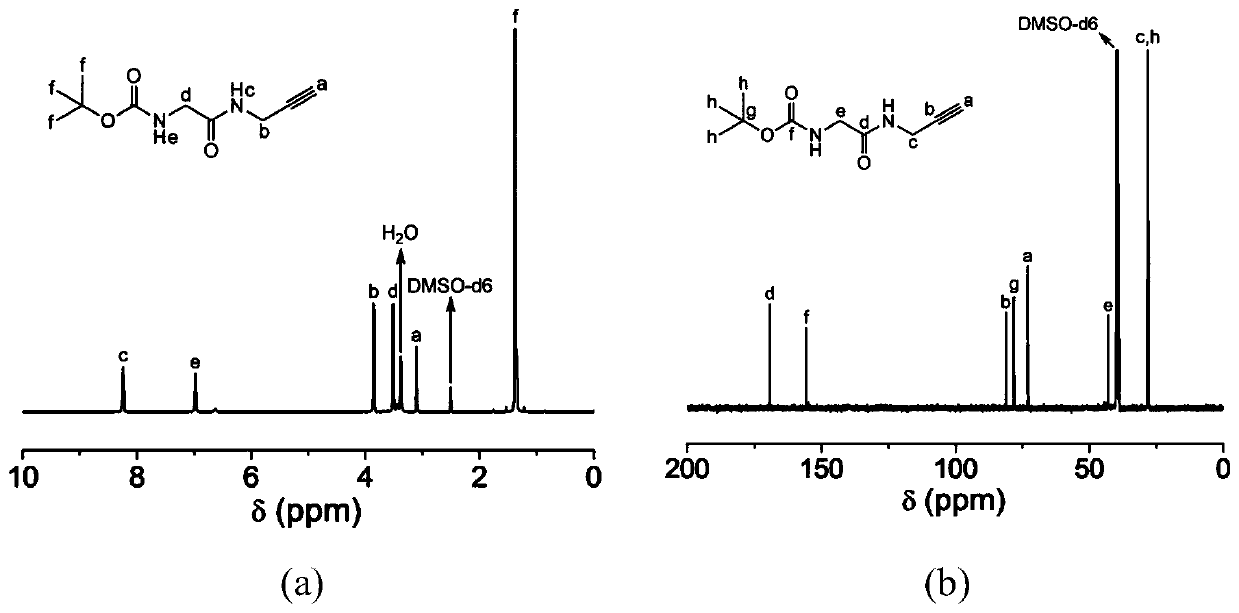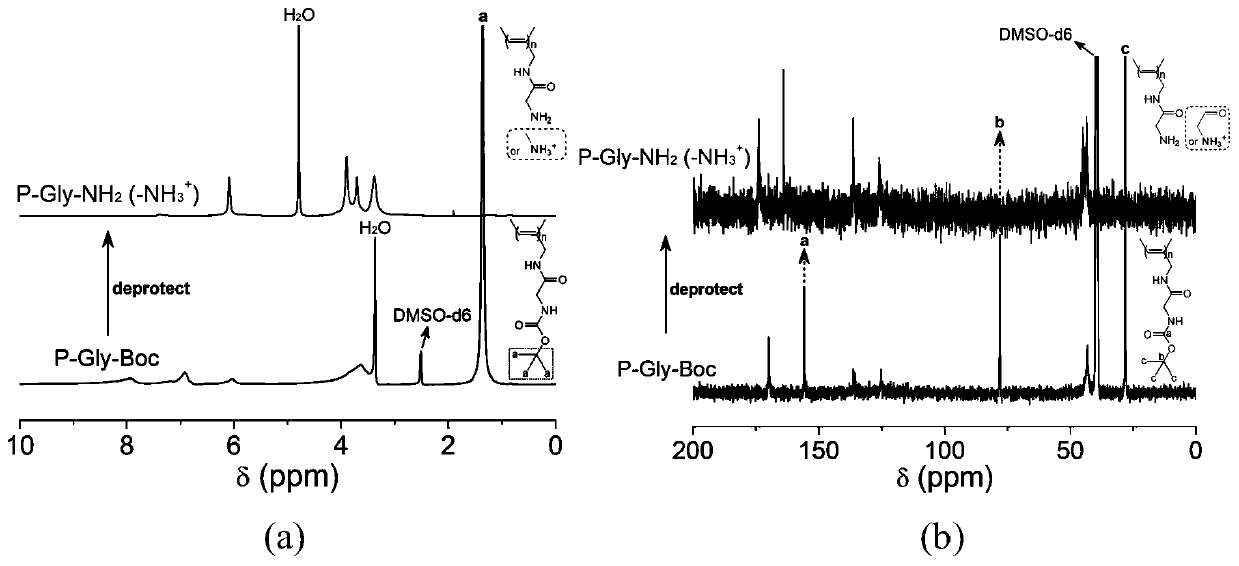Preparation method of substituted polyacetylene type water-phase bivalent copper ion detection probe as well as product and application thereof
A technology of divalent copper ions and detection probes, which can be applied in the measurement of color/spectral properties, etc., can solve the problems of difficult development, limitations, and difficulty in the synthesis of water-soluble substituted polyalkynes, and achieve the effect of reducing synthesis costs.
- Summary
- Abstract
- Description
- Claims
- Application Information
AI Technical Summary
Problems solved by technology
Method used
Image
Examples
Embodiment 1
[0056]The first step is to prepare the substituted alkyne monomer M-Gly-Boc, as follows: Dissolve 1.75 g of N-Boc-glycine (N-tert-butoxycarbonyl-glycine; CAS: 4530-20-5) in 50 mL of tetrahydrofuran, Then add 1.3mL of isobutyl chloroformate and 1.1mL of N-methylmorpholine, after a constant temperature reaction for 15min, then add 0.7mL of propargylamine, and react in a water bath at 30°C for 4h to obtain the M-Gly-Boc solution; Ethyl acetate was used as the extractant, and the resulting solution was washed three times with 30 mL of hydrochloric acid solution (2M), twice with 30 mL of saturated sodium bicarbonate solution, and once with 80 mL of deionized water, then dried by adding anhydrous magnesium sulfate, and then rotary evaporated , purified by freeze crystallization in a THF / n-hexane volume ratio system of 1 / 5. After 5 hours, it was filtered and dried at 30° C. for 24 hours to 48 hours to obtain a solid product of M-Gly-Boc with a yield of 82.1%.
[0057] The second ste...
Embodiment 2
[0076] The first step is to prepare the substituted alkyne monomer M-Gly-Boc, as follows: dissolve 1.75 g of N-Boc-glycine in 50 mL of tetrahydrofuran, then add 1.3 mL of isobutyl chloroformate and 1.1 mL of N-methyl mol After reacting at constant temperature for 15 minutes, add 1.05 mL of propargylamine and react for 4 hours at 30°C in a water bath to obtain the M-Gly-Boc solution; use ethyl acetate as the extraction agent, and use 30 mL of hydrochloric acid solution (2M) Wash three times, wash twice with 30mL saturated sodium bicarbonate solution, wash once with 80mL deionized water, then add anhydrous magnesium sulfate for drying treatment, rotary evaporation, and freeze crystallization in a system with a THF / n-hexane volume ratio of 1 / 5 for purification . After 5 hours, filter and dry at 30° C. for 24 hours to 48 hours to obtain a solid product of M-Gly-Boc.
[0077] The second step is to prepare the substituted polyalkyne P-Gly-Boc, the specific method is as in Example 1...
Embodiment 3
[0081] The first step is to prepare the substituted alkyne monomer M-Gly-Boc, as follows: dissolve 1.75 g of N-Boc-glycine in 50 mL of tetrahydrofuran, then add 1.3 mL of isobutyl chloroformate and 1.1 mL of N-methyl mol After reacting at constant temperature for 15 minutes, add 0.35 mL of propargylamine and react for 4 hours at 30°C in a water bath to obtain the M-Gly-Boc solution; use ethyl acetate as the extractant, and use 30 mL of hydrochloric acid solution (2M) Wash three times, wash twice with 30mL saturated sodium bicarbonate solution, wash once with 80mL deionized water, then add anhydrous magnesium sulfate for drying treatment, rotary evaporation, and freeze crystallization in a system with a THF / n-hexane volume ratio of 1 / 5 for purification . After 5 hours, filter and dry at 30° C. for 24 hours to 48 hours to obtain a solid product of M-Gly-Boc.
[0082] The second step is to prepare the substituted polyalkyne P-Gly-Boc, the specific method is as in Example 1.
[...
PUM
 Login to View More
Login to View More Abstract
Description
Claims
Application Information
 Login to View More
Login to View More - R&D
- Intellectual Property
- Life Sciences
- Materials
- Tech Scout
- Unparalleled Data Quality
- Higher Quality Content
- 60% Fewer Hallucinations
Browse by: Latest US Patents, China's latest patents, Technical Efficacy Thesaurus, Application Domain, Technology Topic, Popular Technical Reports.
© 2025 PatSnap. All rights reserved.Legal|Privacy policy|Modern Slavery Act Transparency Statement|Sitemap|About US| Contact US: help@patsnap.com



